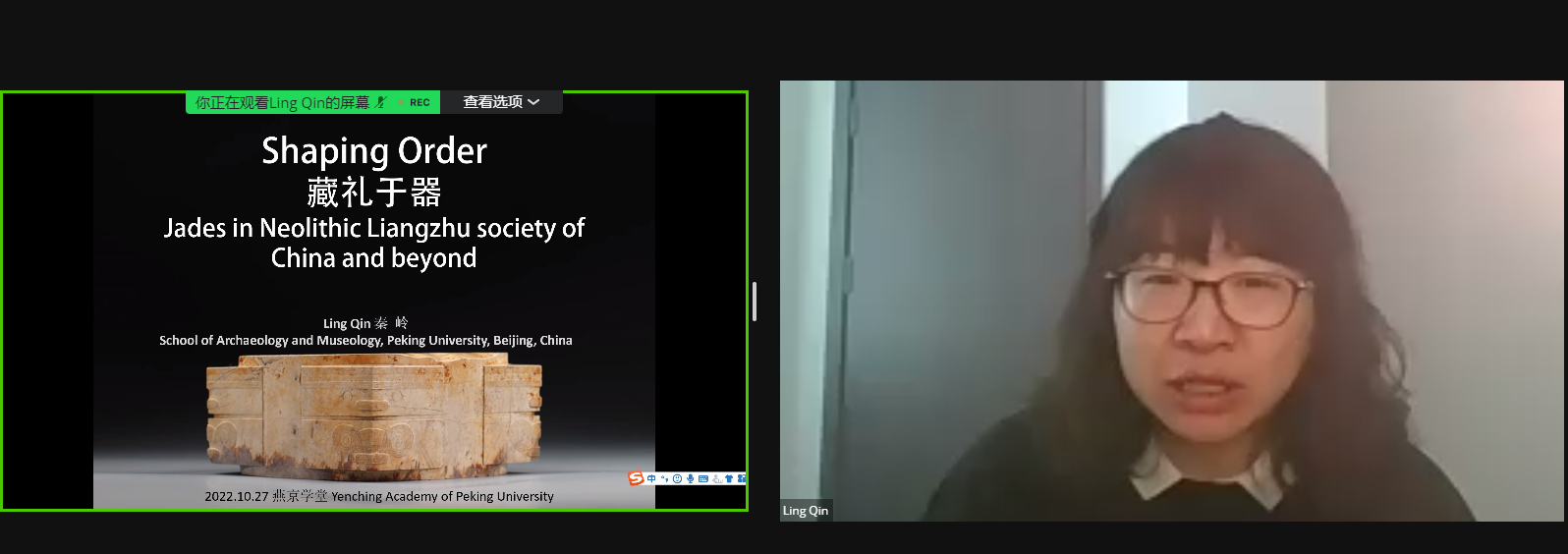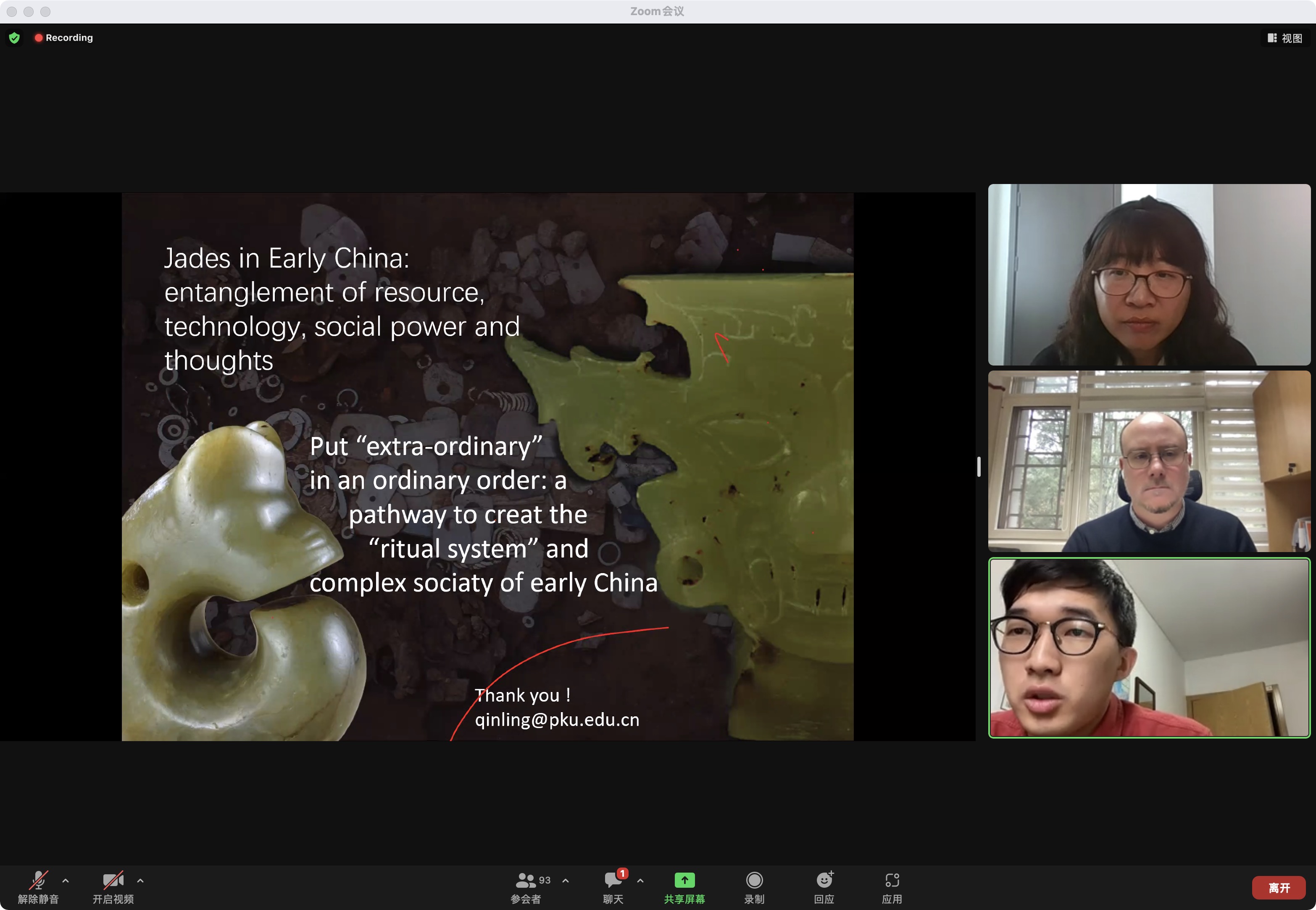On October 27, Associate Professor Qin Ling from the School of Archaeology and Museology, Peking University, gave a lecture at Yenching Academy titled “Shaping Order: Jades in Neolithic Liangzhu Society of China and Beyond”. This class was the fourth in the Yenching Academy’s compulsory “China Studies Lecture Series” for the 2022 Fall semester. Yenching Scholars and teachers joined the lecture hosted by Yenching Academy Associate Dean Brent Haas. The class aimed to provide insights into the framework(s) adopted by archaeologists to understand the ancient Liangzhu society of China by analyzing one of the most popular solid material remains of that society – jades.
Dr. Qin noted that understanding late Neolithic China and the jades’ role in this venture involves three perspectives: a vertical view of Liangzhu jades (3000-2300 BC), a horizontal view of “cong” originating from Liangzhu (2400-1800 BC), and an extended view of “cong” (after the Bronze Age). These views constituted the three segments of the class.

The first segment of the class centered on a description of the Liangzhu society and jades. Existing during the last Neolithic phase in China, the Liangzhu culture, found in the Taihu Lake (south of the Yangtze River delta), flourished for about a millennium – between 3300 and 2300 BC – without any written historical texts or records. Evidence from the archaeological ruins of the Liangzhu City site showed that it had developed infrastructure to facilitate daily activities, including rice agriculture, a water conservatory system, altars and cemeteries, suburb, craft workshops, and over 10 million cubic meters of earthwork and stonework volume.
More so, Dr. Qin stated that the jades were mostly retrieved from the tombs and were significant to the people, symbolizing their belief system, social hierarchy, cultural and gender identity, and individual preferences. Nonetheless, this raises questions about the other ways the Liangzhu people used the jades for their day-to-day activities and how they shaped, designed, and developed their jade (Nephrite) technology without metal tools. Drawing on evidence from a tomb at the Fanshan Cemetery (a King or elitist burial site) at the Liangzhu City site, Dr.Qin explained that some pieces of jade –archaeologists have named the “comb head” – were worn around the head for adornment. It is also believed that some pieces were used across other body parts, like the neck and waist, and several were handheld. These other pieces of jade were called the “cong” and represented social power.
The second section was a cross-regional discussion of areas across China existing around the same time as the Liangzhu society, focusing on the shape, structure, pattern, and technology of the “cong” to provide a perspective into the society’s order and craftsmanship. Dr.Qin explained that the “congs” – oval-shaped materials with multiple layers and patterns (engraved with human and animal motifs) – were created and interpreted by the social groups (producer and consumer), showing a clear hierarchy of how the jades were utilized. More so, round, disc-like materials called “bi” and axe-like materials called “yue” were found alongside the “cong”. It is believed these were worn around the chest and foot to represent an individual’s input for power and wealth, discerned from the quantities worn. Besides, the Liangzhu people used other stonewares, pottery, and (non-metal) agricultural tools to express themselves, denoting a combination of the elite’s aesthetic culture/preference and local traditions.

In this vein, the guest lecturer explained that a quadripartite distribution of power existed in that society, discerned from evidence at the Liangzhu City site, including the patterns, motifs, and quantities of jades found at the burial sites. She compared the Liangzhu City site artifacts and materials excavated from other areas in China, including Shanghai and Shanxi, finding remarkable similarities in their forms and belief systems but differences in their shapes. Dr. Qin clarified that this difference marked a shift in ritual practices involving the jade rather than marking a change in belief systems. “Overall, the Liangzhu jade played an important role in forming the elite, the religion (common thought), and the cultural and social boundary of Liangzhu,” she noted.
Lastly, Dr. Qin discussed a comprehensive view of “cong” (after the Bronze Age). She clarified that the Liangzhu culture’s “cong” experienced several transformations in the later period. One of such transformations was its metaphorical meaning: ritual system (six ritual jades system evident in the 周礼 “Zhou Li” – Rites of Zhou), and cosmology (similar to the popular idea of 天圆地方 “tian yuan di fang” – circular heaven and square earth – in the Han dynasty). Another kind of renovation occurred in the form of the materials used and functionality, e.g., cong-shaped porcelains used for the interment of ashes or the Qianlong Emperor’s (inaccurate) usage of the “cong” as an incense burner.
Dr. Qin concluded that the value of jades in understanding the complex society of early China entails four baseline considerations: the society’s entanglement of resources, technological advancement, distribution of social power, and a pathway to creating thoughts or ritual practices.
Yenching Scholars raised questions during the class. One question reads thus: “If jade products are manifestations of high culture, to what extent can jade objects contribute to establishing the chronological periodization of the Liangzhu culture?” The guest lecturer answered that a typological study of artifacts focused on the shapes and forms of the material remains is one aspect of the chronological periodization of Neolithic societies. Jades are very complicated as they could be reused multiple times because of their durability, and archaeologists researching ancient Chinese societies construe jades through how they were made and the utilized technologies, and their changes in patterns and shapes over the ages. A combination of these data (and carbon dating) give the researcher a rough idea of the era the items belong.
